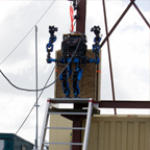Dec 27 2013
16 teams were the main attraction at the DARPA Robotics Challenge (DRC) Trials, where they demonstrated their prototype robots’ ability to perform a number of critical real-world disaster-response skills. DARPA constructed eight tasks at the Homestead Speedway in Homestead, Fla., to simulate what a robot might have to do to safely enter and effectively work inside a disaster zone, while its operator would remain out of harm’s way.
 Team SCHAFT raises the arms of its S-One robot in victory after successfully completing the Climb Industrial Ladder task at the DRC Trials. SCHAFT won that task and three others, and scored the most points of any team at the event.
Team SCHAFT raises the arms of its S-One robot in victory after successfully completing the Climb Industrial Ladder task at the DRC Trials. SCHAFT won that task and three others, and scored the most points of any team at the event.
After two days of competition, DARPA selected eight teams to receive up to $1 million in funding to continue their work. The scores, out of a total of 32 points, were:
- 27 points: SCHAFT (SCHAFT, Inc., Tokyo, Japan)
- 20 points: IHMC Robotics (Florida Institute for Human & Machine Cognition, Pensacola, Fla.)
- 18 points: Tartan Rescue (Carnegie Mellon University, National Robotics Engineering Center, Pittsburgh, Pa.)
- 16 points: Team MIT (Massachusetts Institute of Technology, Computer Science and Artificial Intelligence Laboratory, Boston, Mass.)
- 14 points: RoboSimian (NASA Jet Propulsion Laboratory (JPL), Los Angeles, Calif.)
- 11 points: Team TRACLabs (TRACLabs, Inc., Webster, Tex.)
- 11 points: WPI Robotics Engineering C-Squad (Worcester Polytechnic Institute, Worcester, Mass.)
- 9 points: Team Trooper (Lockheed Martin Advanced Technology Laboratories, Cherry Hill, N.J.)
“At the start of the event, I said that I would be thrilled if even one team scored half the points available,” said Gill Pratt, the DARPA program manager for the DRC, during the event’s closing ceremony. “The event exceeded my expectations multiple, multiple times over, with the top four teams each scoring half or more. The success and reliability of the various hardware and software approaches that the teams demonstrated outside their laboratories was tremendous to see in action and sets an important baseline going forward.”
A number of teams also received special recognition in conducting the eight tasks based on the number of points received and speed:
- Walk Across Rough Terrain; Remove Debris from Doorway; Climb Industrial Ladder; Carry and Connect Fire Hose: SCHAFT
- Open Series of Doors; Cut Through Wall: IHMC Robotics
- Drive and Exit Utility Vehicle: WRECS
- Locate and Close Leaking Valves: Team THOR
The awards ceremony capped off a second day in which spectators—including many families with children—enjoyed an atmosphere similar to a traditional sporting event, not a scientific exercise. In addition to the Trials, DARPA hosted the DRC Exposition that demonstrated first responder exercises and their technology needs.
DARPA Robotics Challenge Trials Day Two Wrap
DARPA Robotics Challenge Trials Exposition
“The DRC Trials demonstrated the difficulty of having robots conduct seemingly simple tasks in real-world situations, and the participation of the first responder community provided an important illustration of how technology can save lives,” said Dr. Brad Tousley, Director of DARPA’s Tactical Technology Office. “This event was yet another example why challenges work to attract new ideas and help quickly advance technology to solve a focused need.”
With the conclusion of the DRC Trials, DARPA and the teams are now looking ahead to the DRC Finals sometime in the next 12-18 months. The Finals will be an opportunity for the eight top teams and the other eight participating teams to continue their efforts alongside new teams to vie for the chance to win the DRC’s $2 million prize.
Pratt has already identified three initial goals for the next competition. “First, we’d like the robots to be more stable so they don’t fall, and if they do fall, be more robust so they won’t break,” he said. “Second, have the robots work without their tethers by using wireless communications and more efficient, self-contained power systems. Finally, we’d like the robots to use more task-level autonomy in unstructured environments such as those found in real disasters.”
More information, images and video are available at www.theroboticschallenge.org.